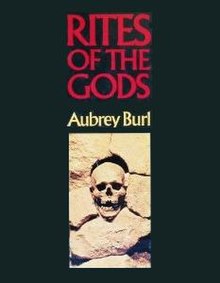Rites of the Gods

The first edition cover of Rites of the Gods.
|
|
| Author | Aubrey Burl |
|---|---|
| Country | United Kingdom |
| Language | English |
| Subject |
Archaeology Religion |
| Publisher | J.M. Dent & Sons Ltd |
|
Publication date
|
1981 |
| Media type | Print (hardcover) |
Rites of the Gods is an archaeological study of religious belief and ritual practices across prehistoric Britain from the Old Stone Age through to the Iron Age. Written by the prominent English archaeologist and megalithic specialist Aubrey Burl, it was first published in 1981 by J.M. Dent & Sons Ltd.
Each chapter explores a different stage in British prehistory, beginning with the Old Stone Age, when the island was inhabited by hunter-gatherers who likely undertook rituals for use in "hunting magic".
Prior to the publication of Rites of the Gods, Burl had already published several books on the subject of prehistoric religion, such as The Stone Circles of the British Isles (1976), Prehistoric Avebury (1979) and Rings of Stone: The Prehistoric Stone Circles of Britain and Ireland (1980).
Chapter one, "Avenues to Antiquity, Blind Alleys and Dead Ends", provides an introduction to the study of prehistoric religion, and the associated problems that come with it. Noting that archaeological evidence has to be supplemented with ethnographic comparisons, proto-historical literature and the study of later folklore, Burl highlights a number of prominent archaeological sites found in Britain that can be used to shed light on ancient religious beliefs, such as Skara Brae, Esh's Barrow and Windmill Hill.
In the second chapter, entitled "The Birth of the Gods", Burl turns his attention to Palaeolithic (Old Stone Age) and Mesolithic (Middle Stone Age) Britain, the periods when the populace – both Neanderthals and Homo sapiens – lived as nomadic hunter-gatherers. Using evidence from across continental Europe to supplement the few finds from Britain, Burl notes that it was the period when humans began ritualistically burying their dead, citing examples like that of the Red Lady of Paviland, providing potential evidence for a belief in an afterlife. He furthermore argues that in this period, the people of Britain saw their landscape in an animistic sense, being inhabited by a multitude of spirits, and that there were various animal cults, in particular dedicated to fierce creatures such as the bear. Turning to look at examples of cave art from across Europe, he draws comparisons with the artworks of contemporary Indigenous Australians, believing that in Stone Age Europe they were used for "hunting magic".
...
Wikipedia
